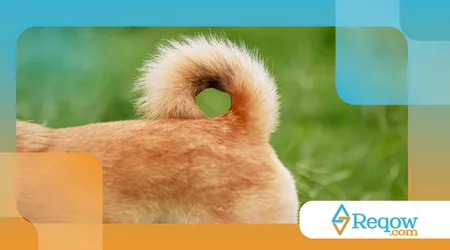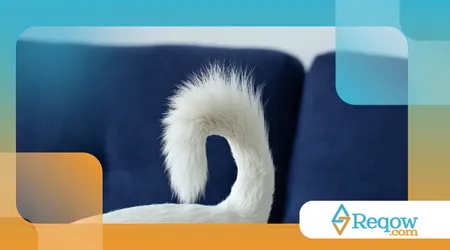Why are some dogs born with curled tails?

THE curled tail In dogs, it's a fascinating trait that sparks the curiosity of animal lovers worldwide.
Advertisements
It's not just an aesthetic charm, but the result of complex genetic and evolutionary interactions.
Why, then, do certain breeds sport this spiral-shaped appendage?
What Lies Behind the Curve? Understanding the Genetics of the Tail
The shape of the tail is determined primarily by bone structure of the caudal vertebrae and by the action of muscles and ligaments. The truth is that the curled tail It's no coincidence.
This characteristic, so prominent in specific breeds, is the product of a process of selection which has spanned centuries. Genetics plays a crucial role.
Advertisements
How does genetic selection shape the curled tail trait?
The spiral shape of the tail is often linked to recessive genes or to a set of genes that act in a coordinated manner.
In many cases, the trait is a byproduct of other selected genes.
Human selective pressure, both natural and artificial, has favored dogs with this appearance. Breeders have prioritized this characteristic in breeds such as the Pug and the Akita.
The process of domestication It also influenced the expression of genes related to the tail. There was a co-occurrence with other phenotypic changes.
Read more: The origin of the names of popular dog breeds
Think about PugIts tail, described as tight and double-curled, is a breed standard. Its ancestors probably did not have it to such a degree of fixation.
Domestication Syndrome: What is the Connection to Tail Curvature?
Current science suggests that the spiral tail may be correlated with what is called... Domestication SyndromeThis syndrome encompasses several common characteristics.
It includes, for example, more flexible ears, shorter snouts, and yes, variations in the tail.
It is believed that a smaller number of neural crest cells contribute to these traits.
Neural crest cells are important in the development of various parts of the body. The tail is one of them.

What other characteristics are linked to the curled tail?
Studies indicate that changes in the neural crest, which influence pigmentation, behavior, and bone structure, also affect the tail. It is a change package.
Imagine that domestication is like flipping a "master switch" in canine DNA.
Look how interesting: Dog Breeds That Have Amazing Abilities
When this switch is activated, several (characteristic) lights turn on or off together.
The phenotype of curled tail It often coexists with other "childish" characteristics. This is a reflection of selection for more docile behaviors.
Facts and Figures: The Science Behind the Curly Tail
A study published in 2017 in the journal Current Biology They identified a region in the genome associated with tail shape. They studied Nordic dogs.
The study highlighted the importance of a specific gene, the T_BX_1 5, which is linked to the development of limbs and tail. Variations in this gene can cause curvature.
++ Precautions to avoid household poisoning
It is essential to recognize that the curled tail It is a polygenic trait. This means that many genes, not just one, control its final expression.
| Typical Curly Tail Breed | Predominant Winding Type | Main Geographic Origin |
| Pug | Tight across the back | China |
| Akita Inu | Double/Single, in a ring | Japan |
| Samoyed | Simple, touch the back. | Siberia |
| Basenji | Tight on the sides | Central Africa |
| Chow Chow | Simple, on the back | China |
In an analysis of genetic diversity in dog breeds, approximately 15% of the breeds recognized by the Fédération Cynologique Internationale (FCI) exhibit the curled tail as a standard of excellence or common trait.
Varieties of Curvature: A Tail Isn't Just a Tail
There is great diversity in the way the tail curves. It can be single, double, loose, tight either positioned on the back or sideways.
The function of the tail is to communication and the balanceA slight shortening or stiffness may have been acceptable.
THE Siberian Husky It has a sickle-shaped tail that rests on its back when alert. It is not as "tight" as a Pug's.
THE curled tail It may even have offered some advantage in cold climates. Keeping the appendix close to the body may help conserve heat.
Isn't nature ingenious in its adaptations and "mistakes" along the way? It's a topic that... deserves attention.

The Impact on Well-being: What Pet Owners Need to Know?
Although it is a breed trait, a very tight or malformed tail can, in rare cases, lead to problems. The tail is part of the spine.
The main focus of attention, for example, is the hygiene in the folds of the tail. Especially in Pugs, where the curling is very pronounced.
THE curled tail It is, in the vast majority of cases, simply a charming trait. The owner only needs to ensure that holistic health of your friend.
Overall, there is no reason for concern. It is, however, one of the many surprises what canine evolution has in store for us.
Celebrating Canine Diversity
The fascinating curled tail It is living proof of the history and genetic diversity of our dogs. It is not a defect.
It is a testament to our selection and evolution. Science continues to unravel the secrets of these genes that shaped canine appearance.
The beauty of the animal kingdom lies precisely in its varietyWe embraced and love this unique feature.
Frequently Asked Questions
Is a curled tail a sign of illness or a health problem?
In most breeds, such as Pugs and Akitas, the curled tail It is a normal genetic trait of the breed and is not considered a disease.
However, in rare cases of severe vertebral malformation (hemivertebrae), which cause coiling, problems may arise.
A veterinarian should assess whether there is pain or limited movement.
Do all Nordic dog breeds have curled tails?
No, not all of them. While many Nordic breeds, such as the Samoyed and Akita, exhibit a spiral or sickle-shaped tail, other breeds from the same region, such as some types of Huskies, may have straighter or only slightly curved tails. The shape is variable and not universal.
Can a curled tail develop in mixed-breed dogs?
Yes, tail curvature is inherited genetically. If a mixed-breed dog inherits the genes responsible for tail curvature from one of its parents, it can indeed develop the trait. curled tail.
The probability will depend on the dominance or recessiveness of the inherited genes.
++ Dog's tail
